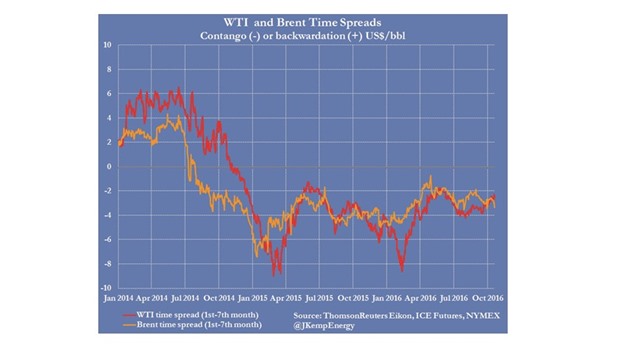Opec’s agreement on an new production target has been followed by a bout of renewed optimism about the rebalancing of the oil market.
But there are so far few signs of imminent rebalancing in the structure of Brent futures prices for 2017.
“Fundamentals are improving and the market is rebalancing,” Saudi Arabia’s energy minister told a conference in London on October 19.
“The recent Opec accord in Algiers was designed to further reinforce the already improving fundamentals,” he explained (“Healthier oil market conditions at hand”, Energy Intelligence, October 20).
There are signs that stocks of crude and products have stabilised and even started to fall after rising since 2014 (“Asia oil markets are tightening as China cuts output, fuel stocks dwindle”, Reuters, October 21 ).
Like the Saudi energy minister, some oil market analysts have become more optimistic the long-awaited turning point in the cycle has at last arrived.
Brent prices for December delivery have climbed $9 per barrel from the recent low in early August reflecting that optimism as well as short covering by hedge funds.
But the forecast rebalancing is not evident in the structure of the forward curve, which is where any tightening in the supply-demand balance should show up.
The timespreads in WTI have risen significantly in recent weeks, mirroring the drawdown in US crude stockpiles.
But timespreads in Brent, more representative of global oil market conditions, have remained weak despite the Algiers agreement.
For many physical traders, timespreads rather than spot prices provide the most reliable guide to the supply-demand-stocks balance (“Brent contango is hard to square with missing barrels”, Reuters, March 9 ).
In the past, a strengthening of crude timespreads has usually coincided with a shift in the supply-demand balance from surplus to deficit.
However, Brent spreads have weakened rather than strengthened in recent weeks and remain far below the highs reported in the second quarter of 2016.
The market is no longer as severely oversupplied as it was in the second half of 2014 and throughout 2015 but there are no signs of it moving into deficit yet which will be needed to draw down stockpiles.
Continued weakness in the spreads suggests many market participants see the road to rebalancing as a long one with a sustained drawdown in crude inventories still some way into the future.
The US Energy Information Administration has predicted that global oil stocks will continue rising through the first half of 2017 and only begin falling in the second half (“Short-Term Energy Outlook”, EIA, October 2016).
The International Energy Agency has reached a similar conclusion: “Our supply-demand outlook suggests that the market — if left to its own devices — may remain in oversupply through the first half of next year.”
The IEA concedes “if Opec sticks to its new target, the market’s rebalancing could come faster” but that remains subject to considerable uncertainty (“Oil Market Report”, IEA, October 2016).
The continued weakness in the Brent spreads suggests that view is shared by the majority of crude market participants.
John Kemp is a Reuters market analyst. The views expressed are his own.

BRENT


